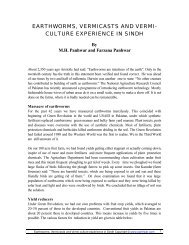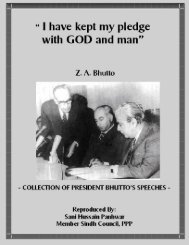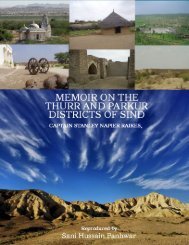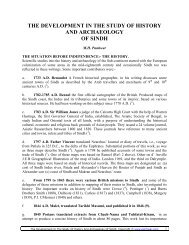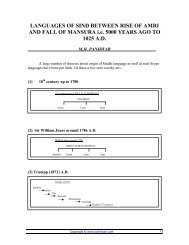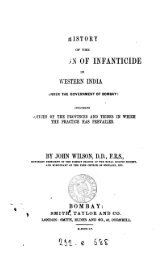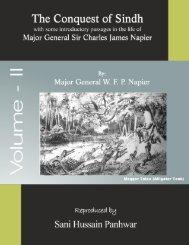IBN BATTUTTA AT SEHWAN (SINDH) - MH Panhwar
IBN BATTUTTA AT SEHWAN (SINDH) - MH Panhwar
IBN BATTUTTA AT SEHWAN (SINDH) - MH Panhwar
You also want an ePaper? Increase the reach of your titles
YUMPU automatically turns print PDFs into web optimized ePapers that Google loves.
People also eat a reptile resembling lizard but having no tail. It probably was Giloi. People<br />
dug sand and fetched it out, then slit its stomach, threw out contents, stuffed it with curcuma<br />
(turmeric) and cooked and ate it. He hated it and did not eat it.<br />
He entered Sehwan in hottest part of year and heat was so intense that his companions sat<br />
naked except a small piece of cloth around their loins and another piece of cloth soaked<br />
with water on their back and shoulders and as this would dry in short time, it had to be<br />
soaked constantly again and again during hot period of the day. (M.H. <strong>Panhwar</strong> had seen it<br />
being done in Dadu Talukas in early thirties by some people in his village, but by 1950<br />
extension of irrigation and cultivation increased humidity and it is no longer being done.)<br />
In Sehwan he met a preacher al Shaibani, who showed in a Sanad (order) issued by Khalif<br />
Omar Ibn al-Aziz Damascus (717-720 AD), appointing his ancestor a preacher of the<br />
town, which post was inherited by him upto to that time. (It is improbable that Khalif<br />
Omar Ibn Abd al-Aziz had issued such a Sanad 600 years earlier.)<br />
At Sehwan he also met Shaikh Muhammad al-Baghdadi, reportedly 140 years old, who<br />
lived in hospice built at tomb of pious Shaikh Usman Marandi and claimed to have seen<br />
death of Mustasin Billah the last Abbasid Khalif. Inspite of his old age he was able to walk<br />
on his own feet. (This statement makes it clear that Qalander Osman [Lal Shahbaz] was<br />
from Marand, a suburb or Tabriz and tomb existed on his grave and was not built by Feroz<br />
Shah Tughlaq who became Sultan eighteen years later and tomb was elaborate enough to<br />
have a hospice for other important persons. That this man was 140 years old and still able<br />
to walk on his own feet is as doubtful as is the age of Qalander him-self.)<br />
He narrates details of Wunar al-Samiri (probably Jam Unar Sama) and Qaisar al-Rumi,<br />
who both were in Sultan’s service and had command of 1800 horseman. There also was a<br />
Hindu accountant of Sultan named Ratan skilled in writing and calculations. Sultan made him<br />
chief of Sindh and governor of Sehwan and its dependencies, with all honours drums, flag<br />
and privileges, accorded to principal amirs. Unar and Qaiser resented about such superior<br />
rank bestowed on an infidel and treacherously killed him, by taking him to a dependent<br />
district and at night created tumult that a lion had entered the camp and in such choas had<br />
him killed. Then they returned to Sehwan seized 12 lacs (gold dinars?). One gold dinar is<br />
Ibn Battutta at Sehwan (Sindh), Copyright © www.panhwar.com<br />
3



